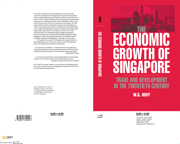Book contents
- Frontmatter
- Contents
- List of figures
- List of tables
- Preface and acknowledgements
- Abbreviations and conventions
- Geographical definitions
- Introduction
- Part One Themes and beginnings
- Part Two Development as a staple port, 1900–1939
- 3 Trade, finance and development
- 4 Ocean-going shipping, the port and regional transport
- 5 Immigration, population and employment
- 6 Rubber: boom and spread of a twentieth-century staple
- 7 Rubber, industrialization and the development of Chinese banking
- 8 Petroleum and tin: the twentieth-century boom commodity and a staple in decline
- 9 The distribution of manufactured imports
- Part Three Staple port and rapid growth, 1947–1990
- 12 Conclusion
- Appendix tables
- Bibliography
- Index
9 - The distribution of manufactured imports
Published online by Cambridge University Press: 22 September 2009
- Frontmatter
- Contents
- List of figures
- List of tables
- Preface and acknowledgements
- Abbreviations and conventions
- Geographical definitions
- Introduction
- Part One Themes and beginnings
- Part Two Development as a staple port, 1900–1939
- 3 Trade, finance and development
- 4 Ocean-going shipping, the port and regional transport
- 5 Immigration, population and employment
- 6 Rubber: boom and spread of a twentieth-century staple
- 7 Rubber, industrialization and the development of Chinese banking
- 8 Petroleum and tin: the twentieth-century boom commodity and a staple in decline
- 9 The distribution of manufactured imports
- Part Three Staple port and rapid growth, 1947–1990
- 12 Conclusion
- Appendix tables
- Bibliography
- Index
Summary
So far, the argument of this book has been that Singapore and its hinterland grew as part of the same process of export-led growth, and that specialization in a few export staples shaped Singapore's economic development. For those in the hinterland and port alike, this specialization raised incomes, and so generated demand for imports of food and manufactured goods. Since the region obtained a high proportion of manufactured goods through the port, Singapore's import of manufactures was large, as discussed in chapter 3.
The present chapter examines the mercantile structure in Singapore associated with its distribution of manufactured imports to city and hinterland. Section I considers the organization of Singapore's import and distribution of manufactured goods until World War II. During the interwar period agency house dominance in this distributive sector was challenged both in the ‘new’ trade in producer goods and consumer durables, as examined in section II, and in the ‘old’ trade in textiles and non-durable consumer goods, the subject of section III. As a result, the distribution of imported manufactured goods contributed powerfully to the increasingly cosmopolitan structure of Singapore's mercantile community which post-World War II economic development would continue to require.
The sources of Singapore's imports of manufactures and its own mercantile structure were closely related, and will be discussed together. Although statistics for imports from the West (table 9.1) contain some non-manufactured items, the figures approximately correspond to the origin of manufactured imports.
- Type
- Chapter
- Information
- The Economic Growth of SingaporeTrade and Development in the Twentieth Century, pp. 257 - 270Publisher: Cambridge University PressPrint publication year: 1994



